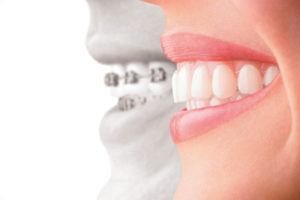Did you know millions of people have straightened their teeth without fixed orthodontic appliances like metal wires and brackets? It’s true. With systems like Invisalign, adults can enjoy comfortable and discreet orthodontic treatment. Invisalign produces tooth movement much like conventional braces. People with spacing issues along with those who have crooked and rotated teeth can benefit from Invisalign treatment.
How Invisalign Works
 Like conventional orthodontics, Invisalign moves teeth by generating force and pressure. This force is what shifts teeth to healthier positions. Unlike braces, however, Invisalign generates force without the need for fixed oral appliances. Instead, patients wear clear, removable appliances called aligners.
Like conventional orthodontics, Invisalign moves teeth by generating force and pressure. This force is what shifts teeth to healthier positions. Unlike braces, however, Invisalign generates force without the need for fixed oral appliances. Instead, patients wear clear, removable appliances called aligners.
Treatment is broken into two-week phases and at the beginning of each phase, patients switch to new aligners that are tighter than the ones worn before. As the aligners get progressively tighter, they can continue to apply the appropriate amount of pressure to meet long-term treatment goals while accommodating new tooth movement. Aligners are worn for approximately 22 hours a day, which gives patients two hours to enjoy meals and perform oral hygiene while their aligners are out.
Benefits of Invisalign
The most obvious benefit of Invisalign is the fact that this is one of the most discreet methods for straightening teeth. Aligners are constructed from clear plastic – making them virtually undetectable to those around you. Adults who have worn Invisalign enjoy the fact that they are not wearing noticeable oral appliances that might be distracting in social and professional settings.
In addition to being practically invisible, this treatment method is comfortable. The soft edges of Invisalign aligners will not cut into or scrape against the linings of lips and cheeks. Moreover, the ability to remove orthodontic appliances for meals and oral hygiene makes this treatment method very convenient and low maintenance.
There are emotional and physical benefits of receiving any kind of orthodontic treatment. Although having a straight smile helps improve one’s self-image and confidence, orthodontic treatment can help extend the life of biological teeth, improve oral function, and prevent the development of issues likes worn dentition and TMJ dysfunction. Properly spaced teeth are easier to brush and floss. This means that patients with straight teeth have a major advantage when it comes to controlling plaque and tartar development. Since plaque and tartar contribute to a host of oral health issues, people with straight smiles who practice proper oral hygiene have much lower risks of developing conditions like cavities and periodontal disease.
Scheduling an Invisalign Consultation
 If Invisalign piques your interest, we recommend calling Kaufman Family Dentistry to schedule a consultation. The only way to be certain this treatment method meets your needs is to speak with our dentist. At your consultation, we will perform an examination to review the placement of your teeth. If we find that Invisalign is right for you, we will discuss how the treatment works and answer any questions you have.
If Invisalign piques your interest, we recommend calling Kaufman Family Dentistry to schedule a consultation. The only way to be certain this treatment method meets your needs is to speak with our dentist. At your consultation, we will perform an examination to review the placement of your teeth. If we find that Invisalign is right for you, we will discuss how the treatment works and answer any questions you have.
Call us today to learn more about Invisalign.



